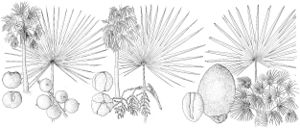Rhapidophyllum
Bot. Zeitung (Berlin) 34: 803. 1876.
| Taxon | Illustrator ⠉ | |
|---|---|---|
 | Coccothrinax argentata Thrinax morrisii Rhapidophyllum hystrix |
Plants small, shrubby. Stems solitary or caespitose, compact, erect or procumbent. Leaves: sheath armed with sharp, stout, needlelike fibers; petiole unarmed; abaxial hastula absent; adaxial hastula a crescent-shaped ridge or flange; blade palmate or weakly costapalmate; plication induplicate (v-shaped), but segments separating between folds to form plications appearing reduplicate (shaped); segments lanceolate, basally connate; cross-veins obscure to conspicuous. Inflorescences axillary, within crown of leaves, closely appressed to trunk, with 1 or 2 orders of branching; prophyll tubular, expanded distally, membranaceous; peduncular bracts 2, expanded distally. Flowers unisexual or bisexual, borne singly along rachillae or densely in clusters of 2 or 3, short pedicellate; sepals 3, distinct to slightly connate at base; petals 3, distinct, tomentose,, orbiculate to acute, fleshy; stamens 6; filaments linear; anthers dorsifixed; staminodes in pistillate flowers 6, with poorly developed anthers; pistils 3, distinct; pistillode in staminate flowers minute. Fruits drupes, ovoid, ellipsoid, or globose; exocarp brown, hirsute; mesocarp mealy; endocarp bony. Seeds ellipsoid, with prominent raphe; endosperm homogeneous; embryo lateral; eophyll undivided, lanceolate. xn = 18.
Discussion
Rhapidophyllum is probably a relictual genus endemic to the southeastern United States. It is most closely related to Trachycarpus H. Wendland of the Himalayan region of southeastern Asia (N. W. Uhl and J. Dransfield 1987). Trachycarpus is the sister group to Rhapidophyllum, which is itself the sister group to the clade containing Guihaia J. Dransfield, S. K. Lee, & F. N. Wei and Rhapis Linnaeus f. ex Aiton, two genera from southeastern Asia (N. W. Uhl et al. 1995). Thoese genera most likely evolved from a widespread common ancestor with a Laurasian distribution. This group of genera is perhaps another example of the well -known eastern North America–eastern Asia disjunction pattern.
Species 1.